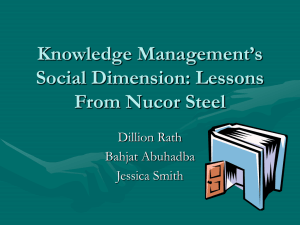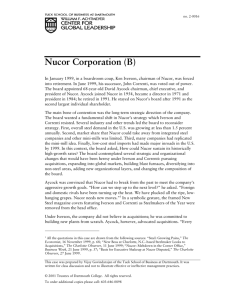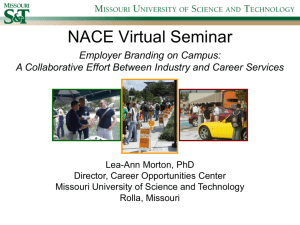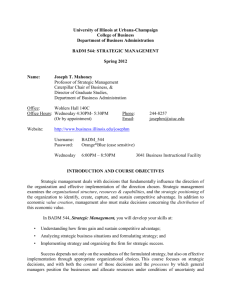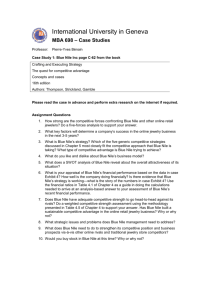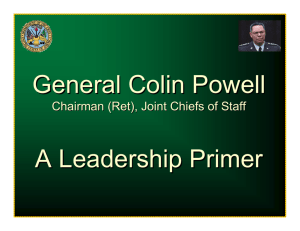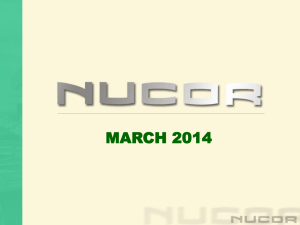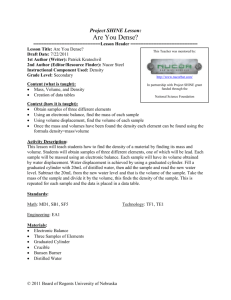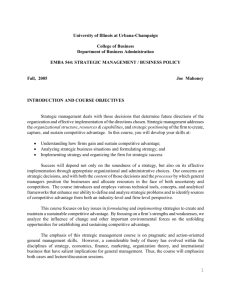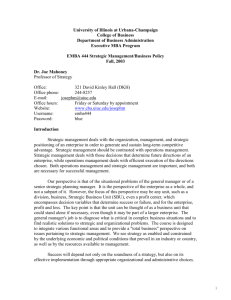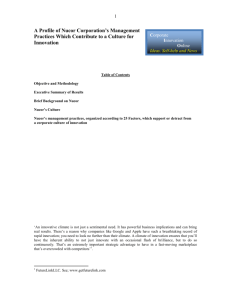Motivation Nucor Steel and the art of motivation
advertisement
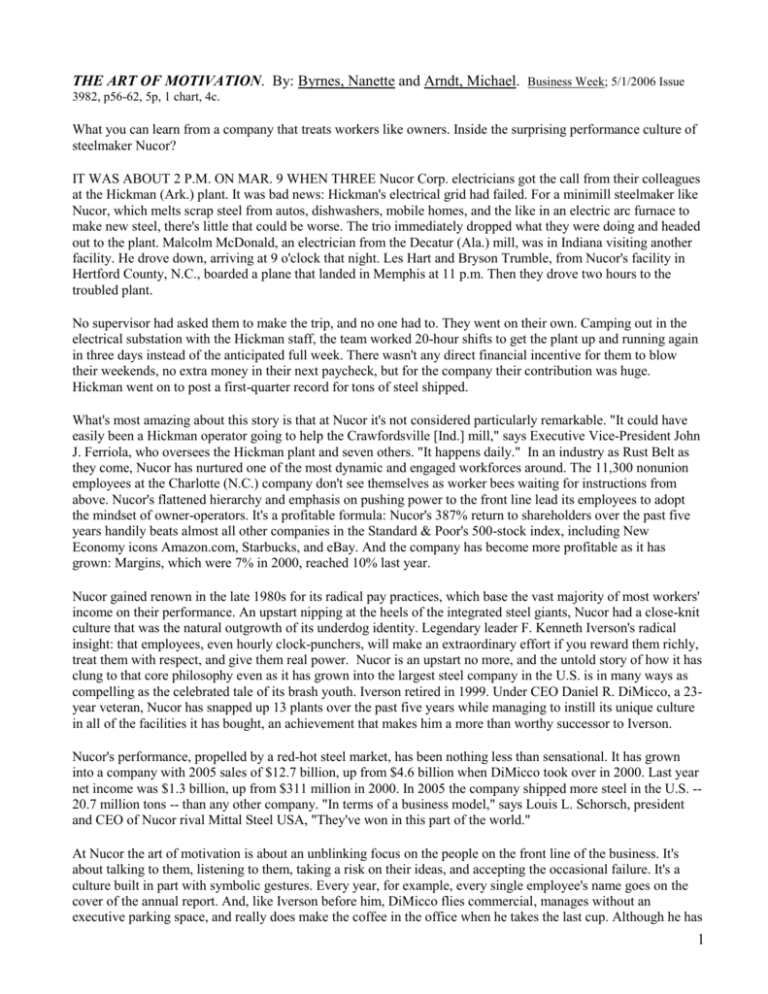
THE ART OF MOTIVATION. By: Byrnes, Nanette and Arndt, Michael. Business Week; 5/1/2006 Issue 3982, p56-62, 5p, 1 chart, 4c. What you can learn from a company that treats workers like owners. Inside the surprising performance culture of steelmaker Nucor? IT WAS ABOUT 2 P.M. ON MAR. 9 WHEN THREE Nucor Corp. electricians got the call from their colleagues at the Hickman (Ark.) plant. It was bad news: Hickman's electrical grid had failed. For a minimill steelmaker like Nucor, which melts scrap steel from autos, dishwashers, mobile homes, and the like in an electric arc furnace to make new steel, there's little that could be worse. The trio immediately dropped what they were doing and headed out to the plant. Malcolm McDonald, an electrician from the Decatur (Ala.) mill, was in Indiana visiting another facility. He drove down, arriving at 9 o'clock that night. Les Hart and Bryson Trumble, from Nucor's facility in Hertford County, N.C., boarded a plane that landed in Memphis at 11 p.m. Then they drove two hours to the troubled plant. No supervisor had asked them to make the trip, and no one had to. They went on their own. Camping out in the electrical substation with the Hickman staff, the team worked 20-hour shifts to get the plant up and running again in three days instead of the anticipated full week. There wasn't any direct financial incentive for them to blow their weekends, no extra money in their next paycheck, but for the company their contribution was huge. Hickman went on to post a first-quarter record for tons of steel shipped. What's most amazing about this story is that at Nucor it's not considered particularly remarkable. "It could have easily been a Hickman operator going to help the Crawfordsville [Ind.] mill," says Executive Vice-President John J. Ferriola, who oversees the Hickman plant and seven others. "It happens daily." In an industry as Rust Belt as they come, Nucor has nurtured one of the most dynamic and engaged workforces around. The 11,300 nonunion employees at the Charlotte (N.C.) company don't see themselves as worker bees waiting for instructions from above. Nucor's flattened hierarchy and emphasis on pushing power to the front line lead its employees to adopt the mindset of owner-operators. It's a profitable formula: Nucor's 387% return to shareholders over the past five years handily beats almost all other companies in the Standard & Poor's 500-stock index, including New Economy icons Amazon.com, Starbucks, and eBay. And the company has become more profitable as it has grown: Margins, which were 7% in 2000, reached 10% last year. Nucor gained renown in the late 1980s for its radical pay practices, which base the vast majority of most workers' income on their performance. An upstart nipping at the heels of the integrated steel giants, Nucor had a close-knit culture that was the natural outgrowth of its underdog identity. Legendary leader F. Kenneth Iverson's radical insight: that employees, even hourly clock-punchers, will make an extraordinary effort if you reward them richly, treat them with respect, and give them real power. Nucor is an upstart no more, and the untold story of how it has clung to that core philosophy even as it has grown into the largest steel company in the U.S. is in many ways as compelling as the celebrated tale of its brash youth. Iverson retired in 1999. Under CEO Daniel R. DiMicco, a 23year veteran, Nucor has snapped up 13 plants over the past five years while managing to instill its unique culture in all of the facilities it has bought, an achievement that makes him a more than worthy successor to Iverson. Nucor's performance, propelled by a red-hot steel market, has been nothing less than sensational. It has grown into a company with 2005 sales of $12.7 billion, up from $4.6 billion when DiMicco took over in 2000. Last year net income was $1.3 billion, up from $311 million in 2000. In 2005 the company shipped more steel in the U.S. -20.7 million tons -- than any other company. "In terms of a business model," says Louis L. Schorsch, president and CEO of Nucor rival Mittal Steel USA, "They've won in this part of the world." At Nucor the art of motivation is about an unblinking focus on the people on the front line of the business. It's about talking to them, listening to them, taking a risk on their ideas, and accepting the occasional failure. It's a culture built in part with symbolic gestures. Every year, for example, every single employee's name goes on the cover of the annual report. And, like Iverson before him, DiMicco flies commercial, manages without an executive parking space, and really does make the coffee in the office when he takes the last cup. Although he has 1 an Ivy League pedigree, including degrees from Brown University and the University of Pennsylvania, DiMicco retains the plain-talking style of a guy raised in a middle-class family in Mt. Kisco, N.Y. Only 65 people -- yes, 65 -- work alongside him at headquarters. At times, workers and managers exhibit a level of passion for the company that can border on the bizarre. Executive Vice-President Joseph A. Rutkowski, an engineer who came up through the mills, speaks of Nucor as a "magic" place, representing the best of American rebelliousness. He says "we epitomize how people should think, should be." EVP Ferriola goes even further: "I consider myself an apostle" for the gospel of Ken Iverson. "After Christ died, people still spread the word. Our culture is a living thing. It will not die because we will not let it die, ever." Strategic Highflier. UNUSUAL? NO DOUBT. But Vijay Govindarajan, a professor at Dartmouth College's Tuck School of Business, teaches Nucor as an example of outstanding strategic execution, placing it alongside highfliers such as JetBlue Airways and eBay. "My students say: 'I thought Nucor created steel.' And I say: 'No. Nucor creates knowledge."' At a time when many observers are busy hammering the final nail into the coffin of American heavy manufacturing, Nucor's business model is well worth considering. It raises the question of whether troubled companies such as General Motors and Ford -- not to mention nonmanufacturers such as Delta Airlines or Verizon Communications -- could energize their workers by adopting some version of this plan. But Nucor's path is hard to follow. It requires managers to abandon the command-and-control model that has dominated American business for the better part of a century, trust their people, and do a much better job of sharing corporate wealth. Money is where the rubber meets the road. Nucor's unusual pay system is the single most daring element of the company's model and the hardest for outsiders and acquired companies to embrace. An experienced steelworker at another company can easily earn $16 to $21 an hour. At Nucor the guarantee is closer to $10. A bonus tied to the production of defect-free steel by an employee's entire shift can triple the average steelworker's take-home pay. With demand for steel scorching these days, payday has become a regular cause for celebration. Nucor gave out more than $220 million in profit sharing and bonuses to the rank and file in 2005. The average Nucor steelworker took home nearly $79,000 last year. Add to that a $2,000 one-time bonus to mark the company's record earnings and almost $18,000, on average, in profit sharing. Not only is good work rewarded, but bad work is penalized. Bonuses are calculated on every order and paid out every week. At the Berkeley mill in Huger, S.C., if workers make a bad batch of steel and catch it before it has moved on, they lose the bonus they otherwise would have made on that shipment. But if it gets to the customer, they lose three times that. Managers don't just ask workers to put a big chunk of their pay at risk. Their own take-home depends heavily on results as well. Department managers typically get a base pay that's 75% to 90% of the market average. But in a great year that same manager might get a bonus of 75% or even 90%, based on the return on assets of the whole plant. "In average-to-bad years, we earn less than our peers in other companies. That's supposed to teach us that we don't want to be average or bad. We want to be good," says James M. Coblin, Nucor's vice-president for human resources. Compared with other U.S. companies, pay disparities are modest at Nucor. Today, the typical CEO makes more than 400 times what a factory worker takes home. Last year, Nucor's chief executive collected a salary and bonus precisely 23 times that of his average steelworker (page 62). DiMicco did well by any reasonable standard, making some $2.3 million in salary and bonus (plus long-term pay equaling $4.9 million), but that's because Nucor is doing well. When things are bad, DiMicco suffers, too. In 2003, as the company was dealing with an industry downturn and barely squeaked out a profit, DiMicco made $1.4 million. He gets few stock options, and most of his restricted stock and other longer-term bonuses don't materialize if the company doesn't beat the competition and outpace a sample group of other high-performing companies for good measure. Paul Hodgson, senior research associate at the Corporate Library, an organization that researches corporate governance issues, and an expert in the field who rarely has anything good to say about CEO compensation, calls Nucor's system a "best practice." Adds Hodgson: "Not too many companies get my vote of approval." 2 Executive pay is geared toward team building. The bonus of a plant manager, a department manager's boss, depends on the entire corporation's return on equity. So there's no glory in winning at your own plant if the others are failing. When EVP Ferriola became general manager of Nucor's Vulcraft plant in Grapeland, Tex., in 1995, he remembers he wasn't in the job two days before he received calls from every other general manager in the Vulcraft division offering to help however they could. (Vulcraft manufactures the steel joists and decks that hold up the ceilings of shopping centers and other buildings.) "It wasn't idle politeness. I took them up on it," says Ferriola. And they wanted him to, he notes. "My performance impacted their paycheck." This high-stakes teamwork can be the hardest thing for a newly acquired plant to get used to. David Hutchins, a frontline supervisor or "lead man" in the rolling mill at Nucor's first big acquisition, its Auburn (N.Y.) plant, describes the old way of thinking. The job of a rolling mill is to thin out the steel made in the hot mill furnace, preparing it to be cut into sheets. In the days before the Nucor acquisition, if the cutting backed up, Hutchins would just take a break. "We'd sit back, have a cup of coffee, and complain: 'Those guys stink,"' he says. "At Nucor, we're not 'you guys' and 'us guys.' It's all of us guys. Wherever the bottleneck is, we go there, and everyone works on it." It took six months to convince Auburn workers that they would do better under Nucor's pay system. During that time the company paid people based on their old formula but posted what they would have received under Nucor's formula. Pretty soon the numbers became a powerful argument to switch. Hutchins saw his pay climb from $53,000 the year before the sale to $67,000 in 2001 and to $92,000 last year. "It's like I got a second job, and I'm doing the same one," he says. Today it has become standard procedure for a team of Nucor vets, including people who work on the plant floor, to visit with their counterparts in any acquisition. They explain the system eye to eye. The payoff for Nucor? In Auburn's second year of Nucor operation, with fewer people and no substantial capital investment, the plant saw a 14% improvement in total shipments. Other acquisitions have seen big jumps in production as well. A mill bought in Tuscaloosa, Ala., went from 800,000 tons a year to 1.2 million with Nucor in just two years. A bar mill in Marion, Ohio, acquired last year, has already pushed annual production from 400,000 tons to 450,000. But to focus only on pay would be to miss something special about the culture Nucor has created. There's a healthy competition among facilities and even among shifts, balanced with a long history of cooperation and ideasharing. Rick Ryan, the shipping department supervisor at the Auburn mill, has taken trips to study plants in Nebraska and South Carolina. Ryan had always used wood blocks as supports beneath the bundles of steel the plant produced. But after seeing other Nucor plants use steel blocks, he switched. Because they can be reused, Ryan figures the move saves $150,000 a year. Since there's always room for improvement, plant managers regularly set up contests for shifts to try to outdo one another on a set goal, generally related to safety, efficiency, or output. Ryan says Nucor's Utah plant is the benchmark these days. It is the most profitable, with the lowest costs per ton. "They've got everything down to a science," says Ryan admiringly. "It gives you something to shoot for." In-House Entrepreneurs. AS NUCOR GROWS, EXISTING facilities making products that overlap with those of acquired plants may need to find new businesses to branch into. So Nucor employees have to innovate themselves out of tough spots and into more profitable ones. The Crawfordsville plant is among those that have felt the squeeze. It's famous as the place that pioneered the commercialization of the thin-strip casting of steel that made it possible for minimills such as Nucor to compete with the industry's Old Guard. But Crawfordsville is not on a large waterway, a disadvantage at a time of high fuel costs. As Nucor's oldest sheet mill, it can't make sheets as wide as many of Nucor's other mills, including a giant plant in Decatur acquired in 2002. So General Manager Ron Dickerson has focused more of Crawfordsville's output on types of steel that are harder to make, more profitable, and less threatened by imports. Now, Crawfordsville can make 160 different grades of steel. Those with a high carbon content, for example, are stronger and lighter and are particularly useful for steel 3 ties for shipping and in car parts. It took a lot of work to figure out how to make this type of steel, which is prone to crack in mid-production, but workers agitated for the chance. They wanted more work for the plant so they could get more hours. Nucor's giant Berkeley mill has gone through a similar evolution, adding new machinery, including a $20 million vacuum degasser used for higher-margin ultraclean steels. The internal competition from Decatur "forced us to get better quicker," says Berkeley's general manager, Ladd Hall. Like many employees, Hall sometimes sounds like a walking advertisement for Nucor. Whisking a visitor out of his office and onto the factory floor, he mentions that he often walks through the plant on Saturday mornings at 5 or 6 a.m. to chat with the line workers before having breakfast with his children at 9 a.m. "I can give you all the rhetoric you want," says Ladd, "but the people in the mills, that's what makes it Nucor." COMPENSATION Payday 2005 . Many of Nucor's rivals have adapted its pay-for-performance philosophy, but Nucor execs, including CEO DiMicco (right), and workers still put more at risk than any of their peers. Here's how 2005 compensation played out for Nucor and US Steel: STOCK* CEO BASE PAY CEO BONUS CEO LONG-TERM PAY** PERCENTAGE OF CEO PAY BASED ON PERFORMANCE CEO STOCK OPTION GRANT (SHARES) TOP EXECUTIVE OPTION GRANTS AS A PERCENTAGE OF TOTAL GIVEN STEELWORKER PAY [t] PERCENTAGE OF STEELWORKER PAY BASED ON PERFORMANCE [T] NUCOR US STEEL Up 27% $707,300 $1.6 million $4.9 million 90% Down 6% $883,340 $1.7 million $4.1 million 84% 20,157 146,500 4% 40% $99,000 66% $70,000 20% * For 12 months ended Dec. 31, 2005 ** Includes restricted stock and long-term incentive plan payout; value of stock options assumes 5% price appreciation. With Nucor, pay reflects the achievement of certain financial goals. [t] Average, includes profit-sharing [T] Hourly pay only Data: SEC filings, Nucor Corp., US Steel Corp. Copyright The McGraw-Hill Companies, Copyright 2006 4
